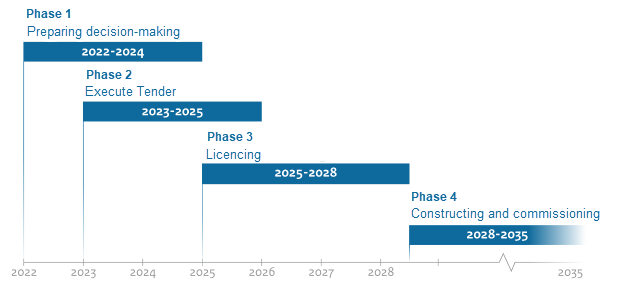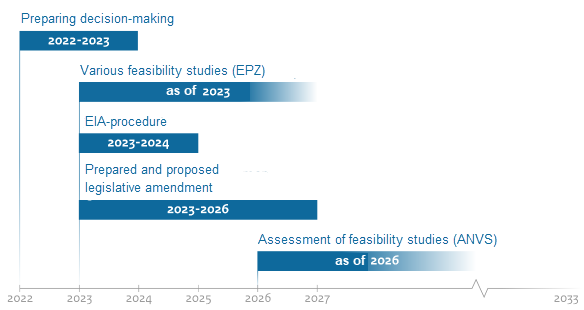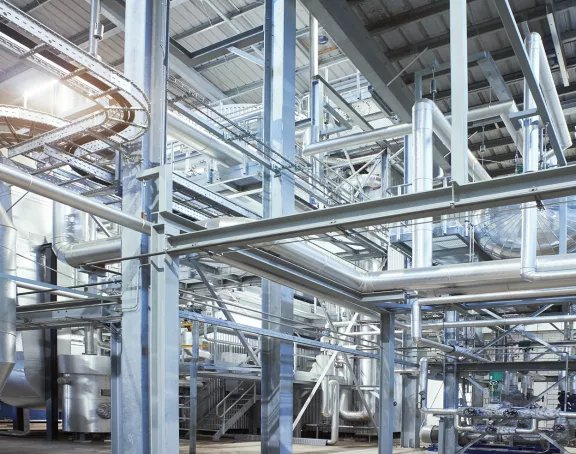The future of nuclear power in the Netherlands (part 2): Borssele preferred site for two new nuclear power plants
On 9 December 2022, Minister Jetten for Climate and Energy presented to the Second Chamber of the House of Representatives his further elaboration of the coalition agreement's intentions on nuclear energy. In a previous blog, we have already discussed in detail the actions arising from the coalition agreement. In this blog post, we interpret the government's thinking on nuclear energy that has taken place since then.
Introduction
On 1 July 2022, Climate and Energy Minister Jetten informed the House of Representatives about the actions taken by the government to implement the coalition agreement on nuclear energy. We covered this in detail in a blog post. Subsequently, the Second Chamber debated the future of nuclear energy in the Netherlands, resulting, among other things, in a new parliamentary letter from the Minister for Climate and Energy dated 9 December 2022. We discuss those in this blog post
Core of the letter
The minister gets straight to the point in his letter, announcing that the cabinet has decided to: (a) bet on the realisation of two new generation III+ nuclear power plants (b) at the preferred site Borssele (Zeeland). Further on in the letter, it appears that a third decision has been taken, namely (c) to work out at least the RAB (Regulated Asset Base) model, whether or not in combination with the PPP (Public Private Partnership) model, for financing.
These are considerable steps in a short time frame, and the minister explains. In the light of climate ambitions, he wants to speed up the realisation of nuclear power plants with operation from 2035 as the target. A planning analysis by Boston Consulting Group shows that this is only feasible by partly parallelising the four phases from preparation to implementation. The minister makes this visible in a 'roadmap for new nuclear power plant construction':

Parallelisation of phases 1 and 2 can only be done by taking an advance now on technology and location preferences. Formally, then, these are decisions of principle, which can still be reversed. This does not seem very likely to us, as it would mean that the time gained would be lost again. Moreover, as will be shown below, the minister has good arguments for opting for the realisation of two generation III+ reactors in Borssele.
Next steps new building
As can be seen from the roadmap above, the minister distinguishes 4 phases up to the commissioning of the newly built power plants:
Phase 1: preparing decision-making (2023 - 2024)
In this phase, the minister aims to present final decisions to the Second Chamber on technology, location, details of the EIA procedure, financing, role of the government, and design of the tender process. This phase will also be used to explore and implement the first concrete steps towards a possible programme organisation to be set up. For this purpose, the minister is also in talks with PALLAS. PALLAS has previously established a programme organisation that is considered sufficiently reliable, competent and mature by the Nuclear Safety and Radiation Protection Authority (ANVS).
Phase 2: execute tender (2023 - 2025)
The minister plans to launch a technical feasibility study in early 2023 to interact with technology suppliers in an early and structured manner and reduce uncertainties around required project costs and timeline. The minister is releasing funds for this technical feasibility study to create an incentive for relevant developers to participate. As there is a limited number of suitable developers with different preferences for financing and cooperation forms, the minister will engage in a market consultation with suitable developers on possible financing and cooperation forms in parallel with the feasibility studies. With this approach, the minister aims to form a realistic view of the conditions under which the project could be commercially viable during 2023. In parallel, a follow-up study on financing models will be carried out. Doing this in parallel would reduce the risks of delays and budget overruns and increase the chances of success of the final tender to arrive at a single party. Based on all these studies, the final tender process can then start in early 2024 to arrive at a party that will eventually implement the project.
Phase 3: licensing (2023 - 2028)
The construction of a nuclear power plant requires an application to the ANVS for a licence under Article 15 of the Nuclear Energy Act (Kew). Ready candidates will be able to enter into preliminary consultations with ANVS in parallel with the tender process. This will require a substantial investment by ANVS, as it will have to enter into consultations with several parties, but this is essential to move through the process with sufficient speed. This means that ANVS's capacity for this will need to be expanded.
Besides a permit based on the Kew, various permits will also be required in the context of space use and the environment. To speed up and streamline decision-making on these, the State Coordination Scheme will therefore be used. This is also mandatory for power plants with a capacity of at least 500 MW, the minister said. In this regard, we note that the national coordination scheme no longer exists under the Environment Act, but will be replaced by the project decision.
In the minister's estimation, this phase from submission of the application to construction will take about three years. That application will be submitted by the winner of the tender, which is scheduled to be known in 2025. These three years are subject to the duration of any objection and appeal procedures, the minister said. This does not strike us as an unnecessary caveat.
Phase 4: construction and commissioning (2028 - 2035)
At this stage, the minister assumes a period of about six to eight years from the start of construction to the actual commissioning of the first nuclear power plant. The length of this period depends partly on any objection and appeal procedures. The starting point here is that two generation III+ reactors, in series construction, will be built at one site. This has several advantages, such as cost efficiency. This phase ends with the application for the operating licence to the ANVS. This is where any (appeal) procedures may affect the timing of actual commissioning.
Choice of two generation III+ reactors.
The minister expects each reactor to have a capacity in the range of 1,000 to 1,650 MW. In our earlier blog, we wrote that a capacity of at least 1,500 MW per reactor is the obvious choice, and the minister seems to recognise this where he speaks of two new plants with a combined capacity of about 3 GW and a capacity factor of 90%. According to the minister, the advantage of the generation III+ reactors is that they are proven technology that (also conceptually) meets the most modern safety requirements while this type is more controllable than, for example, the existing nuclear power plant in Borssele. The latter is important in the overall renewable energy mix because wind and solar are not controllable and it is therefore desirable to buffer their peaks and troughs with a controllable energy source. According to the minister, a type III+ generator could accommodate load variations between 50% and 100% of the rated power at a rate of 3% to 5% per minute several times a day. Of course, voluntary tuning of a nuclear power plant does come at a cost. The minister therefore rightly notes that the extent to which this controllability will be used depends on economic realities.
Choice of Borssele as preferred location
That the minister chose Borssele as the preferred site was not really a surprise. Due to adopted chamber motions, there were in fact only two left of the three safeguard sites (Borssele/Vlissingen, Maasvlakte I in Rotterdam and Eemshaven (municipality of Het Hogeland)). A new nuclear power plant at Eemshaven was considered by a parliamentary majority to be incompatible with gas extraction issues in Groningen. In a parliamentary letter dated 23 December 2022, Minister Jetten therefore indicates that Eemshaven will be scrapped as a safeguard site. For Maasvlakte I, there is a strong commitment to hydrogen. These hydrogen ambitions of both the Rotterdam municipality and the central government are difficult to reconcile with the construction of two nuclear power plants (realising two separate nuclear power plants at different locations is not considered a financially feasible alternative, according to principle 2 of the decision note). However, Maasvlakte I will be considered as a reasonable alternative in the environmental impact assessment. Finally, Borssele scores well on the criteria set out in the letter of 1 July 2022, or has the potential to meet them. The minister adds as plus points: the nuclear infrastructure present, such as the presence of Covra at a short distance from Borssele and the knowledge infrastructure present because of the existing nuclear reactor.
According to the minister, this combination of elements makes Borssele unique compared to the other sites. This suggests that the minister is presumably reluctant to reverse his decision in principle for this site. This is not to say that the Borssele site has no challenges. Elements that require further investigation are at least the environmental effects, the incorporation of the power plants into the high-voltage grid and the integration into the energy system. One area of concern is the capacity of the Zeeland high-voltage grid, especially as there are plans to also connect large amounts of (offshore) wind energy to that grid in the coming period. While it is possible to upgrade the Zeeland grid, experience shows that this takes a long time. Moreover, this will require finding support among the Zeeland population. The minister also seems to recognise this, according to principle 6 of the decision document.
Before a final location decision can be taken, an EIA must first be prepared. It aims to gain an insight into the environmental considerations and interests surrounding the potential sites as soon as possible. In doing so, public participation is relevant, both nationally but, under the Espoo Convention, also internationally. By naming a preferred location now, the minister is somewhat ahead of the troops, which is also pointed out in principle 1 of the decision note. After all, the outcome of the EIA may be that another location should be preferred. In contrast, the minister argues in his letter that by declaring a preferred location now, the government ensures that public participation can take place in a targeted manner.
Knowledge infrastructure
The government's ambitions in the field of nuclear energy call for a structural strengthening of the knowledge infrastructure. In his letter of 18 November 2022, the Minister for Climate and Energy writes that he will strengthen the nuclear knowledge base and infrastructure both initially (by spending the budget of the Erkens/Dassen amendment), and structurally.
Funding
The minister notes that the construction of new nuclear power plants cannot be financed solely by the market. The investment size for a 1,600 MW nuclear power plant is estimated at EUR 5.6 billion, excluding financing costs. Before a new nuclear power plant is operational, it takes a long time and until then no revenues are generated. Moreover, those revenues are uncertain as they depend on unpredictable energy prices. Other risks include sharply rising costs due to setbacks during construction, such as new licensing requirements or long delivery times of required materials. Because of these risks, private financiers will charge high risk premiums, leading to high financing costs and ultimately high costs per MWh produced. Government support is necessary to mitigate financial risks and thus financing costs. For this reason, all nuclear power plants under construction worldwide receive some form of government support. This government support (state aid) has to be assessed with the European Commission. In the Climate Fund, an indicative budget of EUR 5 billion has been set aside for nuclear energy.
It is true that the European Commission has labelled nuclear energy as 'green' within the framework of the Taxonomy Regulation, which may affect the financing of new power plants. But the Netherlands does not currently meet the assessment criteria for nuclear energy to be labelled as green, as formulated by the European Commission. Namely, this requires that, at the time of licensing, final disposal facilities for very low, low and medium-level waste are operational and that, at that time, there is a plan to have a final disposal facility for high-level waste in operation by 2050. On this point, the minister refers to this letter from the State Secretary for Infrastructure and Water Management, also dated 9 December 2022, on nuclear safety in the deployment of nuclear energy. The State Secretary does not consider meeting these conditions feasible for the time being.
In short, due to the complexity and high investment costs, active participation by the central government is essential. In the follow-up process, further consideration will be given to which models (including the RAB and PPP models) are appropriate for the Dutch situation. To this end, the minister will hold early discussions with potential developers in a market consultation and commission a follow-up study in parallel. A technical feasibility study will be launched in early 2023, allowing relevant developers to analyse the technical possibilities, the business case and the project timeline. In late 2024, the minister will inform the Second Chamber about the outcome of the market consultation, the follow-up study on the financial models and a technical feasibility study.
Operating life extension at Borssele nuclear power plant
The minister also mentions the operating life extension of the current Borssele nuclear power plant for the period after 31 December 2033. For this, the minister was able to sign a letter of intent with EPZ and its shareholders PZEM and RWE. The roadmap for the operating life extension is as follows:

Final observations
If you compare the roadmaps for the new construction of the two nuclear power plants at Borssele and for the operating life extension of the existing nuclear power plant at Borssele side by side, you can immediately see that the ANVS and the departments involved face a number of exciting years ahead. Especially if you contrast the plans with the relatively stable situation in the Dutch nuclear sector in recent decades. Add to this the fact that regulations and case law on nuclear power plants at European level are in full swing, and the conclusion is that we will experience 'never a dull moment' in the coming years.
On Stibbe and nuclear power
Stibbe is a full-service firm, assisting government and companies. Stibbe is involved in all relevant projects in the Netherlands relating to nuclear facilities. For decades, Stibbe has assisted EPZ, the operator of the only nuclear power plant in the Netherlands. Stibbe also advises various other parties that play a leading role in this sector.


